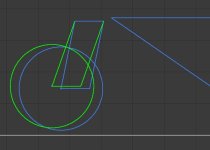This is something I have pondered since building CrazyBike2, and experimenting with various frames during it's conception--a rake/trail setup that varies depending on the speed you are at, so that low-speed riding is not so difficult (especially on recumbents like mine where the normally-helpful pendulum effect is minimal), yet high-speed steering is not twitchy. A steering damper might help with that, I suppose, but I wonder if this might be better than that.
I know that in my experiments with CB2, a more vertical rake with less caster resulted in snappier steering but was harder to ride at faster speeds with my remote steering setup, as it was "twitchy". Less vertical rake, angled more toward the front, with more caster because of it, resulted in sloppier steering and difficult balancing at low speeds, but excellent high-speed stability. Basically I only tested the different rakes with either different size wheels in front and back, and by flipping the fork around, both of which changed the height of rear to front and thus the rake angle (and trail).
For a time I considered making a pivotable headtube that would automatically somehow pivot almost vertical for low speeds, as I came to a stop for instance, and then pivot forward again as I sped up. I did not do this because at that time I had no good way of making this strong and reliable, and had no real ideas for the mechanism itself. Since then, I've run across those folding Razor kickscooters, which have a pivoting headtube for folding them up. A design something like that would probably be strong enough for the average bike (perhaps even for a heavy one like mine).
The main issue I wonder about is if it would be strong enough to resist side-loads and twisting, which is easy if it's welded as a frame but harder if there is the slight sideways freedom of movement it might have as the pivot can rotate thru slots.
I am still not certain of the angle-changing mechanism itself, as it needs a pretty big force multiplier (via gearing, probably), but pondering now it could be operated by braking with some sort of relaxation delay built in, so that as I brake it slowly returns to upright, then when brakes are released it begins to relax outward again. Depending on the angles things are at I'd only need to pull it backward (upright) during braking itself, and gravity would put it back forward once released.
The catch with the latter is that any good bumps like potholes or speedbumps, etc, are likely to push it backwards into the upright position if it is not already there. Also, if braking is the only thing that pulls it upright, I couldn't ride really slowly with it, as Id' have to hold the brake and waste lots of power (and wear the brake pads) trying to keep it upright while still moving forward. So it would probably need some rake-specific control, that did not move at all unless I controlled it to do so, or one monitored by wheel speed and electronically or mechanically controlled by that.
I suspect that it is not worth even trying this, but I'd like some input from those that have built and tried different rakes and whatnot for lower-slung bikes, especially recumbents, or those that know about geometry, frames, suspension, etc.





